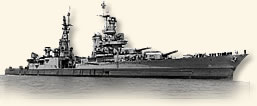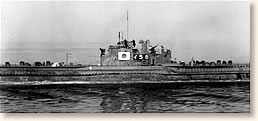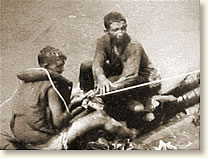|
The Sinking of the
USS Indianapolis, 1945
The heavy cruiser Indianapolis steamed
out of San Francisco Bay just after dawn on July 16 wrapped in a heavy cloak
of secrecy. In her belly, she carried the atomic bomb that three weeks later
would be dropped on the Japanese city of Hiroshima. She raced, unescorted, to
the island of Tinian where she unloaded her lethal cargo on July 26. Her mission
accomplished, the Indianapolis then began a journey into Hell that would end
with the worst naval disaster in U.S. history.
From Tinian she sailed to the island of Guam and from there she was ordered to
the Leyte Gulf in the Philippines to prepare for the invasion of Japan. Traveling
without an escort, her voyage would take her through an oceanic No Man's Land
infested with Japanese submarines and sharks.
 |
| The USS Indianapolis |
At a few minutes past midnight on July 30 two Japanese torpedoes tore into her
side, igniting an explosion that broke the ship in two. It took only twelve minutes
for the ship to dip her bow, roll to starboard and slip beneath the sea. Of her
crew of 1,196, an estimated 900 survived the explosion - but the worst was yet
to come.
A few of those in the water were able to reach a raft or debris from the ship to cling to. Many wore life jackets that provided minimal buoyancy. Just as many, however, had neither raft nor life jacket and were forced to continually tread water to survive, finding relief only when a life jacket became available through the death of a shipmate. The sharks began attacking when the sun rose and continued their assault throughout the ordeal.
No alarm was raised when the ship failed to arrive at its destination. No rescue
forces were dispatched to find the missing ship - its sinking went unnoticed.
For four days a dwindling number of survivors fought a losing battle of life
and death. Then, lady luck intervened. A Navy reconnaissance plane on routine
patrol happened to spot the survivors and broadcast their position. Near-by
ships rushed to the scene and began to pluck the sailors out of the water.
A tally made at the completion of the rescue revealed that only 317 of the
original estimated 900 who escaped the sinking ship survived their ordeal.
Dr. Lewis Haynes was the Chief Medical Officer aboard the Indianapolis. Shortly after his rescue, he dictated his recollections to a corpsman in order to preserve an accurate account of his experience. These notes became the basis of an article published in 1995. We join his story as his sleep is interrupted just after midnight on July 30 by the violent explosion of a Japanese torpedo:
"I awoke. I was in the air. I saw a bright light before
I felt the concussion of the explosion that threw me up in the air almost to
the overhead. A torpedo had detonated under my room. I hit the edge of the
bunk, hit the deck, and stood up. Then the second explosion knocked me down
again. As I landed on the deck I thought, ‘I've got to get the hell out
of here!’ I grabbed my life jacket and started to go out the door. My
room was already on fire.
I emerged to see my neighbor Ken Stout. He said, ‘Let's go,’ and
stepped ahead of me into the main passageway. I was very close to him when
he yelled, ‘Look out!’ and threw his hands up. I lifted the life
jacket in front of my face, and stepped back. As I did, a wall of fire went ‘Whoosh!’ It
burned my hair off, burned my face, and the back of my hands. That's the last
I saw of Ken.
I started out trying to go to the forward ladder to go up on the fo'c'sle
[forecastle - The section of the upper deck of a ship located at the bow forward
of the foremast] deck, There was a lot of fire coming up through the deck right
in front of the dentist's room. That's when I realized I couldn't go forward
and turned to go aft. As I did, I slipped and fell, landing on my hands. I
got third degree burns on my hands - my palms and all the tips of my fingers.
I still have the scars. I was barefooted and the soles of my feet were burned
off.
Then I turned aft to go back through the wardroom. I would have to go through
the wardroom and down a long passageway to the quarterdeck, but there was a
terrible hazy smoke with a peculiar odor. I couldn't breathe and got lost in
the wardroom. I kept bumping into furniture and finally fell into this big
easy chair. I felt so comfortable. I knew I was dying but I really didn't care.
Then someone standing over me said, ‘My God, I'm fainting!’ and
he fell on me. Evidently that gave me a shot of adrenalin and I forced my way
up and out. Somebody was yelling, ‘Open a porthole!’ All power
was out and it was just a red haze.
The ship was beginning to list and I moved to that side of the ship. I found
a porthole already open. Two other guys had gone out through it. I stuck my
head out the porthole, gulping in some air, and found they had left a rope
dangling. I looked down to see water rushing into the ship beneath me. I thought
about going out the porthole into the ocean but I knew I couldn't go in there."
With great effort, Dr. Haynes manages to climb the rope to the deck above. He and an assistant begin to distribute life jackets to those around them. We rejoin his story as the ship lists violently signaling that she is about to sink:
"...I slowly walked down the side of the ship. Another kid came and said he
didn't have a jacket. I had an extra jacket and he put it on. We both jumped
into the water which was covered with fuel oil. I wasn't alone in the water.
The hull was covered with people climbing down.
I didn't want to get sucked down with the ship so I kicked my feet to get
away. And then the ship rose up high. I thought it was going to come down and
crush me. The ship kept leaning out away from me, the aft end rising up and
leaning over as it stood up on its nose. The ship was still going forward at
probably 3 or 4 knots. When it finally sank, it was over a hundred yards from
me. Most of the survivors were strung out anywhere from half a mile to a mile
behind the ship.
Suddenly the ship was gone and it was very quiet. It had only been 12 minutes
since the torpedoes hit. We started to gather together. Being in the water
wasn't an unpleasant experience except that the black fuel oil got in your
nose and eyes. We all looked the same, black oil all over -- white eyes and
red mouths. You couldn't tell the doctor from the boot seamen. Soon everyone
had swallowed fuel oil and gotten sick. Then everyone began vomiting.
At that time, I could have hidden but somebody yelled, ‘Is the doctor
there?’ And I made myself known. From that point on -- and that's probably
why I'm here today -- I was kept so busy I had to keep going. But without any
equipment, from that point on I became a coroner.
 |
The Japanese sub that sank the Indianapolis.
This photo was taken on April 1, 1946
just before the US Navy scuttled the
sub off the coast of Japan. | A lot of men were without life jackets. The kapok life jacket is designed
with a space in the back. Those who had life jackets that were injured, you
could put your arm through that space and pull them up on your hip and keep
them out of the water. And the men were very good about doing this. Further
more, those with jackets supported men without jackets. They held on the back
of them, put their arms through there and held on floating in tandem.
When daylight came we began to get ourselves organized into a group and the
leaders began to come out. When first light came we had between three and four
hundred men in our group. I would guess that probably seven or eight hundred
men made it out of the ship. I began to find the wounded and dead. The only
way I could tell they were dead was to put my finger in their eye. If their
pupils were dilated and they didn't blink I assumed they were dead. We would
then laboriously take off their life jacket and give it to men who didn't have
jackets. In the beginning I took off their dogtags, said The Lord's Prayer,
and let them go. Eventually, I got such an armful of dogtags I couldn't hold
them any longer. Even today, when I try to say The Lord's Prayer or hear it,
I simply lose it.
...The second night, which was Monday night, we had all the men put their
arms through the life jacket of the man in front of him and we made a big mass
so we could stay together. We kept the wounded and those who were sickest in
the center of the pack and that was my territory. Some of the men could doze
off and sleep for a few minutes. The next day we found a life ring. I could
put one very sick man across it to support him.
There was nothing I could do but give advice, bury the dead, save the life
jackets, and try to keep the men from drinking the salt water when we drifted
out of the fuel oil. When the hot sun came out and we were in this crystal
clear water, you were so thirsty you couldn't believe it wasn't good enough
to drink. I had a hard time convincing the men that they shouldn't drink. The
real young ones - you take away their hope, you take away their water and food
- they would drink salt water and then would go fast. I can remember striking
men who were drinking water to try and stop them. They would get diarrhea,
then get more dehydrated, then become very maniacal.
In the beginning, we tried to hold them and support them while they were thrashing
around. And then we found we were losing a good man to get rid of one who had
been bad and drank. As terrible as it may sound, towards the end when they
did this, we shoved them away from the pack because we had to.
The water in that part of the Pacific was warm and good for swimming. But
body temperature is over 98 and when you immerse someone up to their chin in
that water for a couple of days, you're going to chill him down. So at night
we would tie everyone close together to stay warm. But they still had severe
chills which led to fever and delirium. On Tuesday night some guy began yelling, ‘There's
a Jap here and he's trying to kill me.’ And then everybody started to
fight. They were totally out of their minds. A lot of men were killed that
night. A lot of men drowned. Overnight everybody untied themselves and got
scattered in all directions. But you couldn't blame the men. It was mass hysteria.
You became wary of everyone. Till daylight came, you weren't sure. When we
got back together the next day there were a hell of a lot fewer.
I saw only one shark. I remember reaching out trying to grab hold of him.
I thought maybe it would be food. However, when night came, things would bump
against you in the dark or brush against your leg and you would wonder what
it was. But honestly, in the entire 110 hours I was in the water I did not
see a man attacked by a shark. However, the destroyers that picked up the bodies
afterwards found a large number of those bodies. In the report I read 56 bodies
were mutilated, Maybe the sharks were satisfied with the dead; they didn't
have to bite the living.
We rejoin Dr. Haynes' story two days later:
 |
Two survivors are brought
aboard the Cecil J. Doyle | "It was Thursday [2 Aug] when the plane spotted us. By then we were in very
bad shape. The kapok life jacket becomes waterlogged. It's good for about 48
hours. We sunk lower down in the water and you had to think about keeping your
face out of water. I knew we didn't have very long to go. The men were semicomatose.
We were all on the verge of dying when suddenly this plane flew over. I'm here
today because someone on that plane had a sore neck. He went to fix the aerial
and got a stiff neck and lay down in the blister underneath. While he was rubbing
his neck he saw us
The plane dropped life jackets with canisters of water but the canisters ruptured.
Then a PBY [seaplane] showed up and dropped rubber life rafts. We put the sickest
people aboard and the others hung around the side. I found a flask of water
with a 1-ounce cup. I doled out the water, passing the cup down hand to hand.
Not one man cheated and I know how thirsty they were.
Towards the end of the day, just before dark, I found a kit for making fresh
water out of salt water. I tried to read the instructions, but couldn't make
sense of it or get it to work right. My product tasted like salt water and
I didn't want to take a chance so I threw it into the ocean. I then went to
pieces.
I watched the PBY circle and suddenly make an open-sea landing. This took
an awful lot of guts. It hit, went back up in the air and splashed down again.
I thought he'd crashed but he came taxiing back. I found out later he was taxiing
around picking up the singles. If he hadn't done this, I don't think we would
have survived. He stayed on the water during the night and turned his searchlight
up into the sky so the Cecil J. Doyle (DE-368) could find us. The ship came
right over and began picking us up."
References:
This eyewitness account appears in: Haynes, Lewis L. "Survivor
of the Indianapolis." Navy Medicine 86, no.4 (Jul.-Aug. 1995); Stanton, Doug,
In Harm's Way (2001).
How To Cite This Article:
"The Sinking of the USS Indianapolis, 1945," EyeWitness to History, www.eyewitnesstohistory.com (2006).
|






